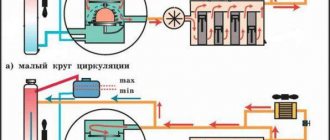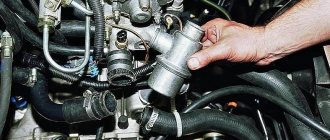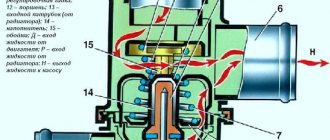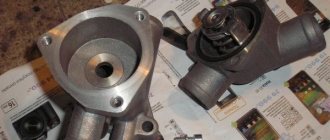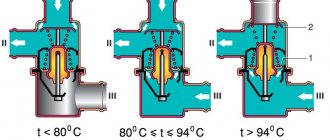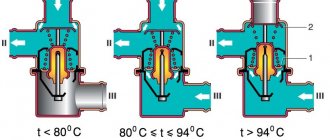If the thermostat fails, the engine will take a very long time to heat up to the required operating temperature, and while driving, the engine temperature will drop sharply. This is especially felt in winter due to a poorly heating stove.
To quickly check the condition of the thermostat, it is not necessary to remove it. To do this, start the cold engine and touch the lower radiator hose. In the normal state of the element, it will first be cold for a short time, but then quickly begin to heat up. This indicates that the coolant is moving along a large contour.
Appearance of the device
Thermostat test VAZ 2108-099,2115 Added
Many people have probably encountered the problem of a stuck thermostat. So I have already installed the fifth thermos. Imagine the FIFTH!
I scoured the Internet. I didn’t find any sensible test or review. Just forums. Therefore, I decided to write my own, I hope I wrote it for good reason, and my experience will help someone make up their mind.
I'll start my test review with the subject
No. 1 called “factory” Worked properly for 3 years. But one cold autumn day, I noticed that the engine temperature was above 70 degrees. doesn't rise. Result: jammed on a large circle. It was decided to send it to the trash heap.
No. 2 thermostat WEEN Poland
Great thermostat! He kept the temperature accurately. The valve did not turn on either in winter or summer, or in any traffic jams. It worked for 1 year. And one hot summer day I noticed. Temp. 103 degrees, and this is on the highway. The valve is working. I set the stove to full heat and somehow got there. Result: jammed in a small circle. The manufacturer did not comply with the 2 years or 150,000 thousand km warranty it declared. Accordingly, WEEN went after the “factory” one, although it’s a shame, the thermos was good.
No. 3 thermostat PRAMO ThermoStato Russia, Stavrovo. 295 rub.
This one is completely bad. Opening the thermo-element too late or not completely was accompanied by the fan running almost every time it stopped. I worked for a year. Result: jammed on a small circle. Somehow I made it home, with the stove on full blast. To the trash heap.
No. 4 BAUTLER BTL0008T China 215 rub.
Sometimes it happens that Chinese spare parts are better than domestic ones. But the miracle did not happen. This one turned out to be complete x. and g...m. Above 85 gr. t of the engine never rose when driving. Only in traffic jams did it reach 91 degrees. Result: Either it’s a defect, or it’s set up for a complete opening. I don't recommend it. Although if you put it on in the summer and take it off for the winter, then that’s it. Summer option so to speak. In my case, winter was approaching, and it was decided to send him after the others.
No. 5 thermostat PRAMO with Polish thermoelement Russia, Vladimir 300 rub.
I use it to this day, the flight is normal. Regulates temperature well. Even in traffic jams and in courtyards, the ventel is silent, only after a whole day of driving it occasionally reminds itself of itself. The engine warms up quite quickly. Bottom line: Good thermostat, for the money. I recommend. Read below
I'm adding
The PRAMO thermostat bent at the end of winter. After the positive review, it started not working so well. Probably jinxed it. What was it? In winter, it warmed for a long time, and when the temperature reached operating temperature, I kept the fan at the limit of turning on the fan. But in the end it jammed into a small circle. Plus it was still leaking along the flaring. Bottom line: don’t take X and G!
How did these thermostats get me, maybe I’m the only one unlucky?
No. 6 thermostat PEKAR 290 rub.
It's too early to draw conclusions. I drove with it for about 1000. Everything is fine. Heats quickly, temperature stays at 90-91C I’ll add
The thermos started leaking like crazy! Was replaced by...
It turned out to be garbage straight away. It didn’t heat up above 80C. I took it off and threw it away.
I decided to seal the PEKAR flare with cold welding. I sealed it and installed it and it no longer leaks. I'm driving like this for now.
Dismantling
If it becomes necessary to remove the thermostat, then it will not be possible to do without draining the coolant. Some craftsmen claim that they were able to avoid the above procedure, but in reality it turns out that this option requires much more labor and still leads to the loss of 3 out of 5 liters of liquid. Therefore, it is better not to suffer and do everything as it should be. To do this, unscrew the plug located at the bottom of the radiator and drain the coolant into a suitable container. Then:
- remove the air filter;
- loosen the clamps holding the hoses;
- disconnect the mass from the thermostat;
- Unscrew the nut and pin holding the device.
Lada 2115 2006, 76 l. With. - spare parts
Cars for sale
Lada 2115 Samara, 2004
Lada 2115 Samara, 2010
Lada 2115 Samara, 2008
Lada 2115 Samara, 2008
Comments 198
Hmmm, trouble. I have a thermos from a dozen, a factory one, I put a lid on it from a luzar, at 92 degrees, winter, I left winter, summer, and now, in the fall, I began to notice that the fan turns on often, yesterday I was driving along the highway, it was -3 degrees outside , and my valve works, the temperature is 97. I arrived, left, the lower pipe is icy, the top is hot, it’s stuck at low, or it opens very late. I’ll have to change the cover again, I don’t think it’s too clever and don’t set it to 92, but judging by the reviews, damn it, I don’t know what to take.
It feels like I opened a Davy Jones locker with thermostats))) I bought a Gates thermostat part from a Lada company store, I ask, is it good? Yes, yes, there have been no complaints yet, well, I think this is not the first time I’m buying, I’ll take my word for it. And as a result, 2 thousand km and the thermostat died on a large circle. I gave 450 rubles + 600 to change, it’s a shame to give the mower away for nothing. I don’t even know what to install, with such quality spare parts you’ll go broke or you’ll learn to fix it yourself. It’s like a company store and they also sell shit. P, S drove 60k on the old thermostat
help me please! VAZ 21099 the main pipe in front of the pump leaked. replaced it, decided to flush the coolant, poured in the flush, warmed up the car, cooled it down to a cold car, washed it with a hose. I rode on normal water for one day, filled it with antifreeze and then trouble began to boil on the road (it was gurgling loudly, air was coming out as if from the engine). I changed the thermostat, valve and temperature sensors, the car overheats anyway (like an envy of a car, after a while the temperature sensor creeps and creeps towards the red mark and Carlson is silent and the car boils). 15 sensors from different stores are of no use to trigger Carlson, I turn off the sensor and Carlson starts directly. The pump was blown up and the whole thing won't turn. There is no oil in the antifreeze, the oil does not foam, there is no steam or precipitation under the oil filler cap. The radiator has been clean for a year (removed and washed) the stove cooks normally. The cover with the extended barrel has been changed, now I drive on water. I force start Carlson after I start the car. When the thermostat opens, the radiator boils, the Carlson sensor gets burned, the TV is also hot, even in the evening you can fry eggs on the TV. On the highway and in traffic jams everything is the same! gases do not enter the coolant.
Greetings. The gasket under the head is broken along the way. Not much. Therefore, gases do not enter.
and Carlson is silent(((is there any point in flushing the system with lemon?
How is the check carried out?
First of all, it is worth pointing out that on a VAZ-2109 (with an 8-valve engine, as well as a 16-valve engine) you do not need to drain the coolant to check. The procedure is:
- start the engine;
- check the temperature of the lower pipe leaving the radiator.
Normally, it should remain cold, since the liquid circulates only in a small circuit. It heats up gradually. As the coolant reaches a temperature ranging from 87 to 92 degrees and the wax in the thermostat melts, the damper opens and a large circle begins to operate. If this does not happen, then the thermostat will have to be changed.
Choosing the right 2108 thermos
delirium611
Experienced
- 15 Jan 2013
- #1
It's time to change the thermostat, it's tripping early. Which to choose? After all, there are a lot of bad brands. Here's what the Barnaul market of thermostats offers: 1. Thermostat VAZ-2108-099, KRAFT Germany (typically) 167 rub. 2. Thermostat VAZ-2108-099 FINORD Finland 175 rub. 3. Thermostat VAZ-2108-099 AT Czech Republic (It seems true) 137 rub. 4. Thermostat VAZ-2108-099 LUZAR LT 0108 Ukraine 153r. 5. Thermostat VAZ-2108 PEKAR Petersburg 174 rub. 7. Thermostat VAZ-2108-099 WEEN B1094 Belgium (Pravda) 185 rub. 8. Thermostat VAZ-2108-099 (Metal) Inkar, Poland (Pravda) 279 rub.
What should I take, gentlemen? Or what is definitely better not to buy?
Automotive holding KRAFT
(Germany), specializing in the production of both industrial goods and spare parts for automobiles, has been on the world market for more than two decades. The company's central office, located in the center of Western Europe, controls the activities of manufacturing enterprises located both in Europe and in Asia. All KRAFT production lines carry out the process of manufacturing and assembling automotive parts using advanced technologies. The KRAFT company has its own certified laboratory and design bureau, which constantly keep under control the entire process and technology for the production of automotive parts and components. All products are manufactured using the latest technical equipment and distributed through a network of representative offices and dealers. Qualified specialists and personnel who have undergone special training at European giant factories actively apply the procedures provided for by European standards, which allows us to ensure the required level of quality and improve production technology. Quality is ensured and maintained throughout the entire product journey - from design to operation. The main part of KRAFT production lines also produces and supplies some components for large automobile concerns
Thermostat VAZ-2108 “Kraft” Catalog number: 2108-1306010-10 Article: KT 019502 Technical characteristics of Kraft thermostats: — Start of opening of the main valve, °C — 85 (±2) — Full opening (valve stroke) no more than 7.6 mm at temperature, °C — 100 (±2) — Full opening time, sec., no more than — 60 — Tightness under pressure, kPa — 149 (±14.9) (1.5 (±0.15) kgf/ cm²)
About the brand "FINORD"
Far to the north lies a country called Finland. It is famous for its 187,888 lakes, the Northern Lights, clear starry skies and white snow. You've probably heard that people here skate on the ice of frozen lakes, ride reindeer sleds through forests covered with white snow, and also enjoy gingerbread and warmed up spiced wine. It is here, on the shores of Lake Keitel, that Suolahti is located, a city with a long history, in which a modern plant for the production of high-quality automotive cooling system components “FINORD” is located. The “FINORD” radiator comes from Finland, it is designed in accordance with strict European quality standards and has an official guarantee from the manufacturer, which fully applies to products sold in Russia.
80°C) the thermostat valve opens, the radiator is included in the cooling circuit and the coolant temperature drops; When the temperature decreases, the reverse process occurs. For a more accurate response to changes in temperature in the coolant environment, the working bypass valve of the thermostat was modified - the cooling system meteredly determines the volume of liquid passing through a large cooling circuit, due to which the engine temperature remains unchanged under any engine operating conditions (both low and high temperatures). high speed).
PEKAR
By choosing PEKAR, you choose stability and safety! For almost a century, PEKAR car parts have ensured stable operation of cars of leading domestic brands. The quality of the products has been tested by time, tested by the Russian climate and domestic roads. PEKAR products are manufactured in Russia, meeting the needs of the automotive and aftermarket markets. PEKAR's portfolio includes several hundred items of products for domestic vehicles (VAZ, IZH, AZLK, GAZ, UAZ, ZIL, PAZ, LIAZ, URAL, KamAZ, MAZ, etc.), including components and spare parts for key vehicle systems - fuel injection, power supply, cooling, heating and lubrication systems. Today, almost every owner of a Russian car knows that the PEKAR brand is an ideal match between quality and price! To achieve high results, the company uses the knowledge of experienced designers, modern technologies and market research. The quality management system at the enterprise complies with the requirements of ISO 9001:2008, and a modern laboratory and measurement center allow for high-level quality control of individual components and finished products.
VAZ-2108, 2109, 21099, 2115, 1111 Oka and their modifications VAZ engines Opening temperature: 85ºС 2108-1306010
WEEN®
– high-quality premium auto components In 2009, WEEN H&H (the Netherlands) and the Japanese Toyota Tsusho Corporation began a joint project to create and market a wide range of premium auto components under the WEEN brand. Products commissioned by Toyota Tsusho Corporation are manufactured in factories located in Europe (UK, the Netherlands and Poland) and Southeast Asia (China and Korea), certified ISO/TS 16949:2002 and audited by Toyota Tsusho Corporation. Toyota Tsusho Corporation carries out full control of production processes and audits the quality of finished products in accordance with its corporate standards, which ensures high consumer characteristics and long service life of WEEN auto components.
Thermostats Technical features High corrosion resistance: the body is made of brass, all internal parts are made of materials that are not susceptible to corrosion Improved material of the control element has reduced the response time by 25% A spring with a specially selected elasticity characteristic that promotes smooth operation of the bypass and main thermostat valves Minimum hydraulic resistance Advantages Corrosion resistance Resistance to temperature fluctuations in the range from –50°C to +150°C Maintaining optimal engine operating temperature in both cold and hot weather Maximum efficiency of heating the vehicle interior Minimum response time Stability of technical parameters Estimated service life of at least 48 months or 160,000 km Warranty 12 months
The Metal-Inkar cooperative is the largest manufacturer in Poland of trouble-free thermostats with wax working substance for internal combustion engines. The company enjoys recognition and good reputation in many European countries. Our company has existed for more than 60 years. The enterprise occupies an area of 18,000 square meters. m. in an attractive location in the city, in the northern district of Warsaw, with access to convenient public transport. The infrastructure includes 4,000 sq. m. production area, 1,200 sq. m. is occupied by utility and administrative premises.
Thermostat 10.0300.01 Samara 1.5 (2108-1306010-11) Year-5/93- 87°C 25- housing
Tuning VAZ 2109
For many, a mystery remains the fact that on some domestic cars, such as the VAZ 2109, a fully operational cooling system, which functions normally even in severe frosts, can be damaged by turning on the heating. Why, in this case, cannot the engine temperature be normalized without using all kinds of devices for insulating the radiator, removing fan blades and other measures? Before finding out the answer to this question, it is necessary to understand the principles of operation of the entire system.
Installing a tuned thermostat
A radiator is a device that performs the functions of heating the interior air and at the same time cooling the liquid. From it, the liquid enters the thermostat, after which it enters the engine water pump. Here it mixes with the cooled heater fluid (similar in principle to a radiator, only has smaller dimensions), accompanied by a decrease in temperature. Moreover, the colder it is, the colder the liquid. As a result, it turns out that the thermostat does not fulfill its purpose, and, as a result, you have to look for ways to prevent hypothermia.
Improving the device to maintain a constant temperature can be done in two ways, discussed in more detail below.
Check and replacement
If the thermostat fails, it should be replaced immediately. It is impossible to say that the device has failed only on the basis of an initial check.
If the engine overheats during operation or does not warm up to operating temperatures quickly enough, the condition of the unit is checked. Based on the results obtained, replacement or repair is carried out.
The most effective way to check the thermostat is to remove it. The procedure is performed as follows:
- Unscrew the crankcase protection mounting bolts, after which the protection must be removed and placed aside for a while.
- Remove the cap from the expansion tank where the coolant is located.
- Place a clean container under the drain hole (if you plan to pour the same coolant back into the system), unscrew the drain plug from the cylinder block and remove all coolant from the cylinder block.
- Place a container under the drain hole of the cooling radiator, unscrew the plug and drain the antifreeze or antifreeze.
- Loosen the clamps holding the hoses.
- Disconnect the three hoses that are connected to your thermostat housing.
- Loosen the tension on the clamps and remove the thermostat along with the hose. The short hose is disconnected from the thermostat.
- Place the dismantled device in a container of water, which must be preheated to 78-80 degrees Celsius.
- Start heating the water, stirring the liquid occasionally. The water needs to be heated to approximately 87 degrees Celsius.
- If the thermostat is working properly, when the temperature reaches 87 degrees with an error of plus or minus 2 degrees, the main valve should open. If this does not happen, the device is faulty and requires replacement.
Replacement process
To replace the thermostat, it is enough to remove the old one in accordance with the specified dismantling instructions, and reassemble the unit with an already working device in the reverse order.
What to choose?
Many owners of a VAZ 2109 with a carburetor complain that the factory thermostat is insufficiently efficient. Because of this, especially in winter, you have to suffer from slow heating, when it is difficult to achieve even 60 degrees.
To solve this problem, it is recommended to install a thermostat from an injection VAZ 2110 with 8 valves for the winter and for the entire period of operation of the nine. This is an improved element that has obvious advantages compared to the original thermostat for the carburetor VAZ 2109.
- You should install an injection thermostat starting from tens, taking into account the fact that we are not talking about the first versions of the VAZ 2110, but later, modernized ones.
- On 8-valve engines, dozens of thermostats have become dismountable, unlike the 16-valve VAZ 2110 and those devices that were initially installed from the factory on the VAZ 2109. This allows, in the event of a unit breakdown, to disassemble it and partially repair it without completely replacing the device.
- To repair a new thermostat, borrowed from a VAZ 2110 with an injector and 8 valves, it is often enough to disassemble the device and replace the thermoelement there.
- The new unit turned out to be 50 millimeters shorter, which allows for more free space.
- The new element has lost many of the clamps that are relevant for thermostats from the VAZ 2109.
- The component has undergone quite a serious modification, which allows it to effectively maintain a stable temperature inside the engine cooling system.
Device from the tens
When replacing the thermostat on a VAZ 21099, make sure that you choose the device from the 8 valve “tens”. Cars with 16 valve engines use different devices in which the circulation system does not work the same way. Therefore, the elements will simply be incompatible.
Connection
To connect a new element from an 8-valve VAZ 2110 to a VAZ 2109, you will need to perform the following steps:
Replacing the thermostat is a useful solution for those who do not want to suffer from the long warm-up of the interior in the winter. Plus, a new element, borrowed from the VAZ 2110 on the VAZ 2109, will allow the engine to warm up faster, and therefore hit the road faster, even in severe frost.
Installation
In addition to the thermostat, you need to purchase a new pipe through which the coolant can return to the pump. Among motorists it is called a “saxophone”. You can find it by number: 2110-1303055-10. The following tools and materials should also be on hand:
- Clamps 15-28 mm (it is better to take about 7 pieces).
- New gasket.
- Replacement hoses.
- Screwdriver Set.
- Special hose puller (needed for old-style cars).
- Rags.
- Antifreeze.
There are two installation options: standard and alternative. In the first case, the 6-hole thermostat opens for additional cooling. In other words, it monitors the temperature coming out of the engine, not the temperature of the already cooled antifreeze. An alternative option is to check the temperature lower than the motor reading. The installation proceeds according to the following scheme:
- Part of the coolant must be drained; to do this, you need to unscrew the plug from the drain hole;
Along with the drop in temperature due to the gradual arrival of winter, it began to get colder in the car. It began to take more time to warm up the engine, then wait for the coolant temperature to rise to 60 degrees to turn on the heater and warm up. In this regard, I remembered the modification of the cooling system of the VAZ 2109, when instead of the standard thermostat, a 6-hole thermostat from the VAZ 2110 is installed. It is improved in comparison with the standard one and has the following advantages:
— the thermostat has been modified to ensure a more stable coolant temperature; — fewer connections on clamps. The standard thermostat is attached to the outlet pipe through a rubber connecting tube; — the thermostat is made collapsible for the possibility of replacing the thermoelement separately from the body; — the new thermostat is 5 cm shorter than the standard one — there is more space.
To remove the thermostat and not spill antifreeze, you must first release the pipe on the throttle assembly and drain what spills out through it. All you have to do is be careful and not spill antifreeze when disconnecting the return pipe from the heater radiator.
We connect a new thermostat with 6 holes according to the following diagram:
Connecting a 6-hole thermostat according to the standard diagram
It will be necessary to install a new pipe through which the antifreeze is sent back to the pump, the so-called “saxophone” (2110-1303055-10), it is shorter than the standard one from the VAZ-2109. However, newer cars already have this pipe installed from the factory. You may also need hoses, clamps, and a gasket for a new thermostat. It is advisable to try on the thermostat and determine locally whether the hoses will need to be replaced.
Above is a standard connection diagram for a 6-hole thermostat. However, it is recommended to connect such a thermostat using a different, modernized circuit.
Modified thermostat connection diagram for VAZ 2109, VAZ 2108 “injector”
Modified thermostat connection diagram for VAZ 2109, VAZ 2108 “carburetor”
Connecting a 6-hole thermostat
The meaning of this connection is that the coolant, which has given off heat in the heater radiator, is directed back to the temperature-sensitive element of the thermostat (rather than drained into the receiving pipe to the pump), and cools it a little, preventing the large circle from opening until the temperature of the antifreeze coming from the heater won't rise. It turns out that now the thermostat also takes into account the temperature of the coolant from the heater radiator, which makes the engine temperature more stable, and the car will be warmer in winter. To connect you will need a special tee.
Thermostat for VAZ 21099 carburetor which is better
The service life of the thermostat for the engine cooling system of VAZ 2108, 2109, 21099 cars is 50-60 thousand kilometers.
This is the best case scenario. It happens that it has to be changed much more often. Let's look at how to quickly and cost-effectively replace a thermostat. — New thermostat
For the cooling system of engines 2108, 21081, 21083 (thermostat 2108-1306010-10 or 2112-1306010).
— Four clamps for pipes
In case the old ones are no longer suitable or there are doubts about their ability to properly compress the pipes.
— Phillips screwdriver or 7 mm wrench
Preparatory work
On engines of VAZ 2108, 2109, 21099 cars, access to the thermostat for replacing it is quite good. The only problem is that it is necessary to drain the coolant, which is a labor-intensive task in the presence of engine mudguards and a sump protection sheet.
Therefore, we will drain the liquid from the Solex carburetor heating block.
We remove the long hose from it (by loosening the clamp) and drain the liquid into a container with a volume of at least four liters (or several plastic bottles). The coolant level in the engine cooling system will drop well below the thermostat and it can be quickly removed and replaced with a new one.
Replacing the thermostat of the engine cooling system of VAZ 2108, 2109, 21099 cars
— Loosen the four thermostat clamps
We do this using a Phillips screwdriver or a wrench.
— Remove the old thermostat
— Installing a new thermostat
Before installation, wipe the pipes going to the thermostat dry. If there is old sealant, carefully remove it. We install the new thermostat without sealant. Since its pieces that come off can clog the channels of the cooling system (and this impairs the coolant circulation and overheats the engine). If necessary, change the clamps on the pipes.
— Add coolant to normal level
We start the engine and expel any air pockets from the system, check the operation of the engine cooling system with a new thermostat (the first and second circles of the cooling system should gradually warm up in turn, and then the fan on the radiator should turn on).
Notes and additions
— Installing a new thermostat is a reason to simultaneously check the condition of the cooling system pipes, the cleanliness of the expansion tank plug, and the fastening of the clamps.
More articles on engine cooling system 2108, 2109, 21099
— Features of replacing the coolant of the cooling system of engines 2108, 21081, 21083
If you direct the fluid from the heater to the thermostat, the temperature in the engine and interior will be normal in winter and summer.
I’m probably not the only one who thought about why a serviceable cooling system in our cars, when the heater is turned on in cold weather, does not provide the normal thermal conditions of the engine without the use of various kinds of radiator insulation, throttle washers in the pipes, removal of the fan impeller and other measures.
Almost all domestic ones have a fundamentally identical cooling system (Fig. 1, a) - with a lower location of the thermostat, where it automatically maintains the coolant temperature within specified limits. For example, in a Moskvich 80–95°C, in front-wheel drive VAZs, Oka, Tavria 87–102°C, etc. The VAZ 2109 thermostat usually performs this function properly even in any frost (to certain limits) , and in any engine operating modes... until the heater is turned on. What's the matter?
Rice. 1. Diagram of the standard (a) and converted (b) cooling systems of Muscovites, Zhigulis and others.
- 1 – thermostat;
- 2 – engine radiator;
- 3 – radiator fan;
- 4 – expansion tank;
- 5 – temperature indicator sensor;
- 6 – coolant pump;
- 7 – engine cooling jacket;
- 8 – heater fan;
- 9 – heater radiator;
- 10 – heater valve;
- 11 – plug;
- 12 – additional pipe (from the VAZ-2108 thermostat).
Let's consider the operation of the system. On the one hand, the radiator is a heater of the air entering the cabin, on the other, it is a liquid cooler. The heater is almost the same radiator as the main one, only smaller in size. From the main radiator, cooled liquid enters the thermostat, and then through it goes into the engine to the water pump. Here it is mixed with cooled fluid from the heater. What is her temperature after this? Clearly lower. And the stronger the frost, the colder it is. And the thermostat, it turns out, is on the side, literally and figuratively. At this moment, they usually put cardboard or a cover on the radiator so that the liquid in it cools less.
Question: can a thermostat from 2108 be installed in 2110?
Radiator fan does not turn off on 2110i Yesterday I decided to replace the thermostat due to the radiator fan constantly turning on (the radiator itself was quite cool when the fan was running). Having removed it, I discovered that the thermostat I had was “of the wrong system,” i.e. Externally the same, but internally different. It has a small circle; when the valve of the large circle is opened, it does not close (there is a hole in the valve of the small circle). Those. Of the two paths, the liquid chooses the one with less resistance - the small circle, and not much goes to the big one. The computer monitors the fan turning on using a temperature sensor located on the engine. Hence the engine is overheating, the radiator is cool, and the fan is constantly running. I bought a “normal thermostat” in the store, the fan almost doesn’t turn on unless you stand still for hours. Well, ideally, I’m thinking of redoing it by installing a thermostat from 08, removing the tee. On the thermostat itself it says “Made in Russia 85C N8” and a stamp like C= (Stavrovo), nothing else that looks different. The one I installed says the same thing! But everything is different inside: the one that, in my opinion, is “not quite correct” - it has a hole coming out of the end of the cylinder ALWAYS closed by a valve, although it has a calibrated hole of about 7-8 mm, with a “correct” thermostat this hole is open to ~ 100C, and closes when this temperature is reached by a valve, which is connected through rods by the main valve (opening a large circle). In principle, after installing the “correct” thermostat, the problem with a constantly on fan, a cold radiator and an overheated engine was solved, but I still don’t like something (some kind of seething and foam in the tank). I think that we need to install a thermostat and redo it as it was done in 8-9. Expert commentary.
It is impossible to connect the expansion tank to thermostat 2108 on a 2110 car, because a degassing tube from the heater radiator is connected to the expansion tank 2110, and air is constantly removed from the heater radiator through it.
Connecting the expansion tank to thermostat 2108 on a 2110 car will lead to airing of the heater radiator, because In winter, the main thermostat valve practically does not open, and degassing of the heater radiator does not occur. At VAZ, work is underway to change the design of the thermostat in order to eliminate the defective hose with tee 2110-8101201. Aleshin Vladimir Aleksandrovich Directorate for Technical Development of JSC AVTOVAZ Special Testing Directorate, Thermal and Climatic Testing Department
Method No. 1
As you know, after the heater, the liquid must flow to the “nine” thermostat, since it controls the cooling system. The problem is that it will not be possible to connect to any of its pipes using a tee, since the entire operation of the system will be disrupted. There is only one way out - to build a new pipe into the thermostat. It is advisable to place it opposite the existing pipe, closer to the housing connector, in general, where the liquid is best mixed.
Modified thermostat
Having carried out the necessary work, we got an updated system in which, in addition to the previous fluid flows controlled by the position of the thermostat valves, a new control flow appeared.
To verify whether the task was solved, a special experiment was conducted. His results were undoubtedly pleasing: the temperature at both measurement points (1 - the upper part of the thermostat, 2 - the water pump housing) was 78 ° C and, regardless of the operating mode of the engine, radiator and heater, it remained unchanged. In addition, according to subjective sensations, engine performance, in general, also improved, and the interior began to be heated much more efficiently.
